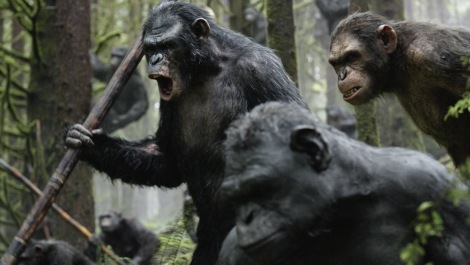Why you can trust GamesRadar+
What a difference a decade makes. In 2001, Fox execs were still scratching their heads over where to take their ailing, 35-year-old Planet Of The Apes franchise after the critical drubbing dished out to Tim Burton’s big-budget B-movie reboot. It took them a while – 10 years in fact – to reach a solution: Rupert Wyatt’s game-changing prequel, Rise Of The Planet Of The Apes .
Doing away with the traditional actors-in-suits approach, Wyatt employed Oscar-winning Kiwi geniuses WETA Digital to create photorealistic, performance-captured simians and gave us a film that melded cutting-edge FX spectacle with a surprisingly affecting cautionary tale of corporate greed, animal cruelty and science getting ahead of itself… Critics and audiences agreed: the franchise had its edge back.
Yep, a lot can change in 10 years. It’s a concept that Cloverfield director Matt Reeves’ mines for his Rise follow-up, Dawn Of The Planet Of The Apes . A chilling yet beautifully rendered 3D redux of the previous film’s end credits sequence sets the scene, with news snippets revealing that the world’s population has been decimated by the ‘simian flu’ virus – a potent by-product of the first film’s lab testing.
A decade later, chimp Caesar (Andy Serkis) and his band of intelligent apes have founded a fledgling civilisation in the woods of San Francisco, presuming all humans to be dead. His peaceful existence is threatened, though, by the intrusion of Malcolm (Jason Clarke), a man searching for energy supplies to power a settlement of genetically immune survivors within the city ruins. The two form a frail, grudging truce, though growing distrust and militant factions on both sides soon threaten all-out war.
Not quite the intimate parable of the first movie nor a balls-to-the-wall battlefield extravaganza, Dawn is pitched somewhere in the middle, with much of its two hour-plus running time powered by the simmering, expertly sustained tension both between and within the two species. The key to selling this knife-edge friction, of course, is the ability to buy into the apes as fully fleshed-out characters.
And while WETA’s exemplary effects (much improved even in the three years since Rise ), the stunning production design of ape city and even the intricacies of their developing language (delicately transitioning from subtitled signing to stunted speech throughout) all help maintain the illusion, the film’s success is ultimately guaranteed by the actors in the skin-tight grey suits…
Building on his already impressive credentials, Serkis’ older, more world-weary Caeser is another masterclass in endlessly expressive, often heartbreaking digital performance. He’s got some standout support, too, in the form of perf-cap newcomer Toby Kebbell – taking over as Koba, Rise ’s mentally (and physically) scarred lab rat. Koba’s pumped-up role this time out demanded an extraordinary performance and Kebbell more than delivers, oozing menace and empathy in equal measure.
With the pair’s relationship and conflicting ideologies proving so integral to the story – Caesar’s progessive belief in peaceful co-existence thanks to his experiences with former keeper Will (James Franco – glimpsed briefly in archive footage) versus Koba’s ape-supremacist leanings and unflinching hatred of the humans that tortured him – it’s testament to the actors’ extraordinary, engrossing turns that, unlike so many summer tentpoles, it never once feels that you’re watching pixels. In fact, the effect is so subtle that it’s sometimes easy to forget quite what an outstanding technical achievement this is.
There’s no mistaking Dawn ’s technical prowess when it comes to its big set-pieces, though. From Caeser’s initial show of force to his potential new aggressors (apes on horseback!) to a wincingly brutal, vertigo-inducing showdown atop a collapsing tower block, the filmmakers really have outdone themselves on the spectacle front. Dawn marks the first time that 3D performance capture has been shot outside of a studio and it shows, adding a level of realism that many modern blockbusters strive for but fail to achieve.
Even if Dawn ’s running time often seems a little stretched, especially towards the end of the film’s second act, Reeves nonetheless strikes an admirable balance between the large-scale action sequences and the smaller, more intimate scenes – from Caesar’s own parenting troubles to human camp leader Gary Oldman’s brief but moving meltdown on seeing a photo of his (presumably obliterated) family.
Wisely, despite being saddled with some clunky exposition early on, the film’s human characters are also given plenty of heft, with Clarke, Oldman, Keri Russell and Kodi Smit-McPhee (Malcom’s girlfriend and son, respectively) all turning in convincing, sympathetic performances. The only frustratingly weak link is Kirk Avecedo’s Carver, a paper-thin, token a-hole who constantly threatens to derail the ape-human trust because the story demands it, rather than having any plausible motivations of his own.
Still, it’s a minor annoyance in a film full of endless invention, spectacular scale and poignant drama. As a post-apocalyptic tale of interspecies conflict, two tribes fighting for their place in a brave new world, Dawn Of The Planet Of The Apes is both unapologetically bleak and yet surprisingly hopeful, proving itself as so much more than a mere prelude to the main event. Make no mistake though, this isn’t the end. As Caesar ominously intones, “War is coming.” And if Reeves’ bar-setting sequel is anything to go by, it’s going to be big…



